10.04.2020
Next SpaceX Starlink launch set for next week from Kennedy Space Center
Despite the U.S. Space Force recently postponing the national security launch of a GPS satellite due to coronavirus concerns, the 45th Space Wing will support the upcoming SpaceX Starlink launch on April 16.
“We believe that we can continue to do the range operations, to be able to support them without any harm to our personnel.” Brig. Gen. Doug Schiess said on a call with reporters Thursday afternoon.
The Space Force is evaluating each launch on a case by case basis. Because this is not a national security mission, less military personnel are required.
“We don’t own the satellite for Starlink and so that’s up to SpaceX how many people they have whereas for the GPS launch there would be Space Force people that would be needed that are not needed for the Starlink launch,” Gen. Schiess said.
In addition, the SpaceX Falcon 9 rocket uses an autonomous flight safety system that requires the least amount of personnel on console.
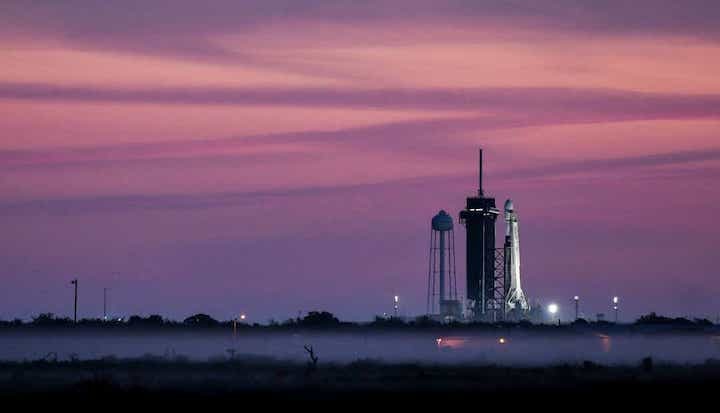
Around 200 people are needed to support the launch including firefighters, security forces and civil engineers. One hundred of those are range personnel who are inside on console during the launch working in close quarters. Gen. Schiess said they are practicing physical distancing and wearing face masks according to CDC guidelines.
“If we felt like this was too risky to do then we would push,” Gen. Schiess added.
Gen. Schiess also made the point that if they stopped supporting launches altogether there would be a backlog on the schedule which could affect a national security mission later.
No personnel that live or work on either Patrick Air Force Base or Cape Canaveral Air Force station have tested positive for the coronavirus. According to Gen. Schiess, less than 100 people have been tested.
The seventh batch of SpaceX Starlink satellites is headed for low-Earth orbit aboard a Falcon 9 rocket from pad 39A at Kennedy Space Center April 16. If successful, that will bring the total number of Starlink satellites to 420.
Quelle: Florida Today
----
Update: 15.04.2020
.
Florida launch range remains open; Falcon 9 mission postponed
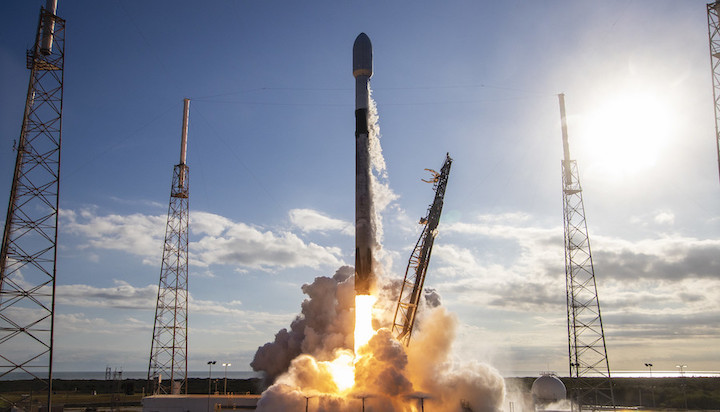
Range personnel at Cape Canaveral will employ physical distancing, face covers and other cautionary measures to reduce the risk of spreading the coronavirus during launch operations, the commander of the U.S. military’s 45th Space Wing said.
But the next launch from Cape Canaveral has been postponed from Thursday until no earlier than next week, sources said. SpaceX is planning to fire off a Falcon 9 rocket with the next batch of Starlink Internet satellites.
The private satellite launch this week was scheduled for Thursday despite the coronavirus pandemic, which has forced delays in other space missions at Cape Canaveral. The U.S. Space Force said last week the next launch of a GPS navigation satellite — part of the country’s national security space program — has been delayed from late April until late June to protect ground crews from the virus.
SpaceX’s launch launch of around 60 more satellites for the company’s Starlink network could still happen next week, sources said. Officials have not disclosed a reason for the delay from Thursday.
With the Starlink project, SpaceX will deploy at least 1,500 orbiting relay nodes — and potentially thousands more — to beam Internet signals to homes and businesses around the world.
The next batch of Starlink satellites are scheduled to blast off from pad 39A at NASA’s Kennedy Space Center, adjacent to Cape Canaveral Air Force Station.
A SpaceX spokesperson has not responded to questions on the impact of the pandemic on the company’s operations.
Brig. Gen. Doug Schiess, commander of the military unit that oversees range operations at Cape Canaveral, said last week that the Starlink launch is not “mission-critical” for U.S. national security. But he said the Eastern Range remains open for launches from Cape Canaveral, and teams are taking steps to protect themselves from the virus.
“In looking at this, we believe that we can continue to do the range operations to be able to support (SpaceX) without any harm to our personnel, or our ability to do … public safety and resource protection,” said Schiess, commander of the Space Force’s 45th Space Wing.
Continuing with launch operations will also help ensure the schedule at Cape Canaveral later this year doesn’t become too busy, Schiess said last week.
“From a mission standpoint … it keeps our folks trained and ready, and then it doesn’t have an impact on the launch manifest later in the year,” he told reporters Thursday. “If we’re not doing any launches, then obviously things would start to back up, and then it may affect a national security launch at a later time.”
Teams in the range control center at Cape Canaveral Air Force Station will practice physical distancing during near-term launches, Schiess said, just as they did during the most recent launch from the Florida spaceport March 26.
On that mission, a United Launch Alliance Atlas 5 rocket lifted off from Cape Canaveral with a U.S. military communications satellite. A separate range crew will oversee the upcoming SpaceX mission, providing safety, security, weather forecasting and other support services required for every space mission that departs Cape Canaveral.
“We’re taking some precautions, and we’ve split our crews up, and also ask them health questions before they’re allowed into the operations center,” Schiess said.
Schiess has ordered all personnel working at Cape Canaveral Air Force Station to use face coverings if they can’t maintain at least 6 feet of physical distancing from other people.
“We’re not taking any risk to the individuals, and that’s why each mission is being looked at individually,” he said. “If we felt like this was too risky to do, then we would push (delay the launch).”
If a range team member tests positive for the coronavirus, Schiess said a separate team could be rotated in for the SpaceX launch.
Around 200 people are needed to provide range services for a SpaceX launch, with roughly 100 crew members stationed in range operations centers. The others, including security patrols, will be located at other sites on the spaceport.
SpaceX’s Falcon 9 and Falcon Heavy rockets use autonomous flight safety systems, which would automatically trigger a destruct command on the rocket if it flew off course. That reduces the personnel required to provide range safety support.
Schiess said more than 300 range personnel are required for United Launch Alliance missions, which use flight termination systems that would be manually commanded by a range safety officer on the ground.
The 45th Space Wing is evaluating the impacts of the coronavirus pandemic on a mission-by-mission basis, Schiess said.
“When it comes to me to approve the date that is on the launch schedule, thats when we do a little more (thinking) about what are we doing to mitigate the spread of the virus, and make sure that we’re safe,” he said.
Schiess said military officials are assessing how rescue teams at Patrick Air Force Base, located south of Cape Canaveral, can be trained and on standby for the planned launch of SpaceX’s Crew Dragon capsule with astronauts as soon as next month.
Military rescue teams at Patrick Air Force Base would be deployed to retrieve the astronauts on the Crew Dragon in the event of an abort after liftoff. Those rescue teams are scheduled to receive “just in time” training for the job before the Crew Dragon launch, which is scheduled for late May.
Meanwhile, construction and maintenance work continues at Cape Canaveral Air Force Station. Blue Origin is building a new launch pad for its New Glenn rocket, and Schiess said he was not aware of any impacts from the coronavirus on the construction.
“As long as their contractors and subcontractors meet the requirements, they can still continue to get on the base,” he said. “We see that at mission-essential kind of work.”
Workers completed an upgrade to the capacity of the spaceport’s helium system earlier this month, Schiess said. The system routes helium to various launch pads to provide pressurization gases for loading on rockets.
Quelle: SN
----
Update: 16.04.2020
.
SpaceX now targeting next week for Starlink launch from Kennedy Space Center
SpaceX teams are now targeting next week for the launch of a Falcon 9 rocket from Kennedy Space Center with a batch of the company's internet-beaming broadband satellites.
If schedules hold, the 230-foot-tall rocket will vault off pad 39A at 3:16 p.m. next Thursday, followed by a first stage landing on the Of Course I Still Love You drone ship in the Atlantic. A Space Force-issued weather forecast for the attempt is expected Monday.
This mission will mark SpaceX's seventh for its Starlink constellation, an effort to transmit internet connectivity to remote and underserved users around the world. If successful, it will bring the network's size to more than 400 small satellites in low-Earth orbit.
The mission comes as the coronavirus pandemic impacts all sectors of the economy – and space isn't excluded. SpaceX has already had to delay one mission – an Argentinian communications satellite – due to the virus, but space as a whole is considered essential to economic activity and national security.
Though SpaceX operates pad 39A for its own missions, it's still on Kennedy Space Center property. The center is at Stage 3 of NASA's Response Framework, meaning employees who can must work from home and only mission-essential work is allowed on-center. Travel is limited, too.
Preparing for the agency's upcoming Space Launch System rocket, for example, is considered essential, and hundreds of employees and contractors are supporting the program at KSC. On Monday, the rocket's launch abort motor, which helps propel astronauts away in the event of an emergency, arrived at KSC from Promontory, Utah.
Quelle: Florida Today
----
Update: 17.04.2020
.
SpaceX Falcon 9 rocket rolls to launch pad earlier than usual for next Starlink mission
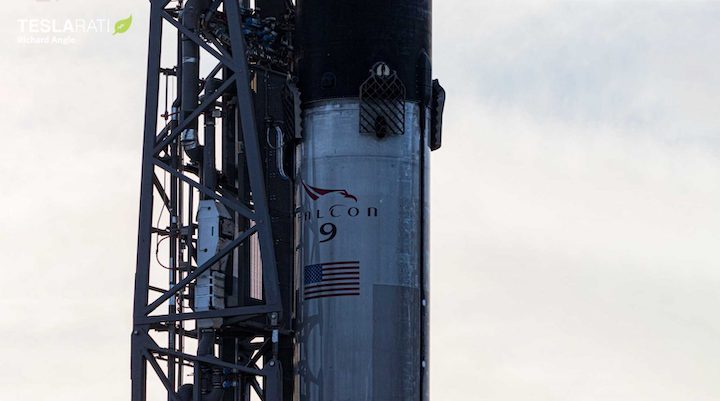
A SpaceX Falcon 9 rocket has rolled to the launch pad a full week before the company’s next 60-satellite Starlink launch is scheduled, much earlier than usual compared to all recent Starlink missions.
Thrice-flown Falcon 9 booster B1051 will be supporting the internal SpaceX launch, serving as a partial return-to-flight mission after a Falcon 9 rocket suffered its first in-flight engine failure since 2012 less than a month ago. Recently discussed on Teslarati, prime customer NASA – perhaps just a month away from its first astronaut launch on a SpaceX Crew Dragon and Falcon 9 – has to outwardly worry about the impact of Falcon 9’s March 18th engine failure. Most recently, administrator Jim Bridenstine signaled that SpaceX had already effectively determined the failure mode enough for him to state that it’s “not going to impact our commercial crew launch.”
Likely implying that the engine failure was closely related to the fact that Falcon 9 booster B1048 was on its fifth launch, a first for SpaceX, a successful Starlink launch next week would likely alleviate most remaining customer concerns. Delayed a week from April 16th to 23rd, the rocket’s move to the launch pad indicates that SpaceX may be exerting significantly more caution on this particular Starlink launch, a sign that the company is unsurprisingly prioritizing a fully-successful mission over speed.
Excluding delays, recent SpaceX Starlink launches have seen their Falcon 9 rockets roll out to the launch pad and perform their preflight static fire tests just a few days (or less) before liftoff. To achieve that, SpaceX – for the first time since September 2016 – has begun installing payloads (its own Starlink satellites) on top of Falcon 9 before their static fires. Known as Starlink V1 L6 or Starlink-6 for short, that also remains true for this particular mission – SpaceX’s 6th Starlink launch since November 2019 and 7th launch overall.
Easily visible in Spaceflight Now’s live views of Falcon 9’s roll to the launch pad, the rocket already has a payload fairing – presumably full of 60 Starlink satellites – installed atop its second stage. The fact that SpaceX has rolled the fully-integrated Starlink-6 rocket to the launch pad a full week before its planned liftoff is thus at least a little curious.
The presence of a payload fairing effectively rules out an issue with Starlink satellites as the cause of the delay, while it also makes it much less likely – but not impossible – that any bugs were found in Falcon 9’s first or second stages. Were any such issues discovered, it’s hard to imagine that SpaceX would have chosen to roll the fully-integrated rocket to the launch pad, as any hardware issues would almost certainly require a return to the hangar and some level of disassembly.
As such, the reason for the rocket’s relatively early move to the launch pad is a bit of a mystery. Most likely, as briefly noted, SpaceX is simply taking a more cautious approach to this launch as a result of challenges faced in February and March. The use of Pad 39A – normally dedicated to Falcon Heavy and Crew Dragon launches – also raises the stakes a bit, as a vehicle failure on or around the launch pad would inherently result in major delays to NASA’s critical Commercial Crew Program astronaut launches.
Either way, SpaceX’s Starlink-6 mission is set to be uniquely high-profile. According to launch photographer Ben Cooper, Falcon 9 is scheduled to launch no earlier than 3:16 pm EDT (19:16 UTC) on Thursday, April 23rd. Stay tuned for updates as the rocket approaches its static fire test.
Quelle: TESLARATI
----
Update: 18.04.2020
.
SpaceX test-fires rocket for Starlink launch next week
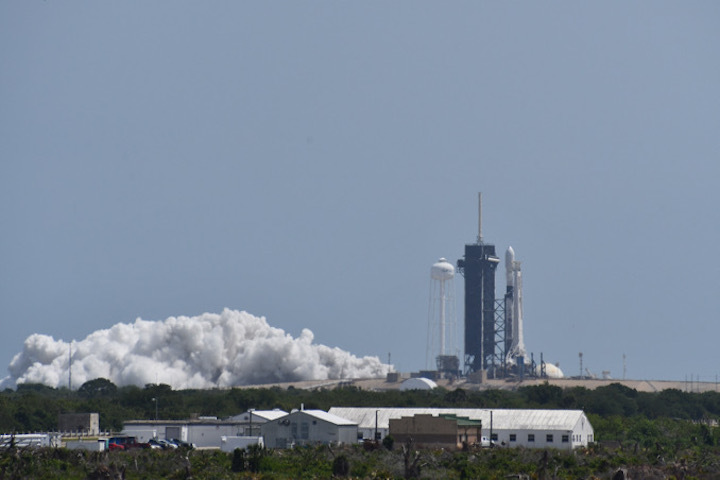
SpaceX test-fired a Falcon 9 rocket with a previously-flown first stage booster Friday at NASA’s Kennedy Space Center in Florida, keeping pace for a launch scheduled next Thursday, April 23, with the next batch of 60 Starlink broadband Internet satellites.
The rocket’s nine Merlin kerosene-fed first stage engines ramped up to full throttle to produce 1.7 million pounds of thrust for several seconds at 12 p.m. EDT (1600 GMT) Friday. Hold-down restraints kept the 229-foot-tall (70-meter) rocket firmly on the ground.
A plume of rocket exhaust erupted from pad 39A’s flame trench, and SpaceX later tweeted to confirm the successful completion of the static fire test, a routine milestone during all of the company’s launch campaigns.
SpaceX says the Falcon 9 rocket is scheduled for launch at 3:16 p.m. EDT (1916 GMT) on April 23 carrying the company’s next batch of 60 Starlink broadband Internet satellites into orbit.
The launch was previously delayed from April 16.
Launch operations at Cape Canaveral are continuing amid the coronavirus pandemic, although at a reduced pace. Two launches planned in March and April, both using SpaceX Falcon 9 rockets, have been postponed at the request of SpaceX customers due to impacts from the COVID-19 viral disease.
An Argentine radar observation satellite was scheduled to launch March 30 from Cape Canaveral, and a U.S. military GPS navigation satellite was planned for launch April 29. Argentine and U.S. military officials ordered the missions delayed.
The U.S. military’s 45th Space Wing, which providers range support for launches from Florida’s Space Coast, remains open and ready to support rocket missions. Brig. Gen. Doug Schiess, the wing’s commander, said earlier this month that range personnel and contractors working at Cape Canaveral will follow strict physical distancing guidelines, and anyone working at the spaceport should wear face coverings if they are unable to maintain at least six feet of distancing from other people.

Schiess said April 9 that the Starlink launch is not “mission-critical” for U.S. national security. But he said launches should continue if teams are safe.
“We’re not taking any risk to the individuals, and that’s why each mission is being looked at individually,” Schiess said. “If we felt like this was too risky to do, then we would push (delay the launch).”
The launch next week will be the first since a Falcon 9 rocket suffered an engine failure on SpaceX’s most recent mission March 18. On that flight, one of the nine first stage Merlin engines shut down prematurely. The Falcon 9 overcame the engine anomaly and dipped into its performance reserve to place the 60 Starlink satellites on that mission into their intended orbit.
With assistance from NASA and the U.S. Space Force, SpaceX has investigated the engine failure over the last few weeks. NASA Administrator Jim Bridenstine said April 9 that engineers have a “good understanding” of the engine failure, and the agency does not anticipate it impacting plans for the first launch of astronauts on a SpaceX Crew Dragon spacecraft next month.
NASA announced Friday a target launch date of May 27 for the Crew Dragon test flight, designated Demo-2.
SpaceX has not disclosed the cause of the Merlin engine anomaly on last month’s mission, which used a first stage booster making its fifth trip to space.
The booster test-fired Friday at the Kennedy Space Center is a veteran of three previous Falcon 9 missions. It first launched in March 2019 from Florida on the first unpiloted test flight SpaceX’s Crew Dragon spacecraft, then flew again in June from Vandenberg Air Force Base in California with three Canadian Radarsat Earth observation satellites.
Most recently, the stage — designated B1051 — launched Jan. 29 from Cape Canaveral with SpaceX’s fourth batch of 60 Starlink satellites.
The rocket landed on SpaceX’s offshore drone ships after each of its previous missions.
SpaceX is also reusing a payload fairing on next week’s Starlink launch that was previously launched and recovered. The two-part payload shroud, which encloses satellites on top of the launch vehicle, flew in August 2019 with the Israeli Amos 17 communications satellite.
One of SpaceX’s ocean-going fairing recovery ships, fitted with a giant net, caught one half of the fairing after the Amos 17 launch. The other fairing half was plucked from the sea and returned to port.

The launch next week will grow the size of SpaceX’s Starlink network to more than 400 satellites, more spacecraft than in any other company’s fleet.
SpaceX has launched 362 Starlink satellites to date, including test versions. Since last May, SpaceX has launched six dedicated Falcon 9 flights for the Starlink network, each with 60 satellites on-board.
SpaceX aims to deploy more than 1,500 Starlink satellites to provide near-global Internet connectivity, serving businesses, schools, the U.S. military and private citizens. Thousands more Starlink satellites could eventually be launched by SpaceX, which has regulatory approval to operate nearly 12,000 spacecraft to beam Internet signals from space.
Each of SpaceX’s Starlink satellites is built at the company’s spacecraft development site in Redmond, Washington. The flat-panel, solar-powered relay stations each weigh about a quarter-ton, and are designed to climb into an operational orbit some 341 miles (550 kilometers) above Earth using krypton ion thrusters.
SpaceX has not publicized connectivity speeds or prices for consumer-grade connectivity through the Starlink network. But Musk gave prospective customers a taste of what they could expect.
“It will be very low latency, and we’re targeting latency below 20 milliseconds, so somebody could play a fast response video game at a competitive level,” Musk said in early March. “That’s the threshold for latency. And bandwidth? The bandwidth is a very complex question. Let’s just say somebody will be able to watch high-definition movies, play video games, and do all the things they want to do without noticing speed.”
Musk said SpaceX is not currently thinking about spinning off the Starlink project to form another company, adding that his main goal is ensuring that Starlink is a viable business after previous attempts to build large constellations of communications satellites in low Earth orbit ran into trouble.
“We need to make the thing work,” he said. “It’s real important to just set the stage here for LEO communications constellations. Guess how many LEO constellations didn’t go bankrupt? Zero.”
OneWeb, a competitor to SpaceX’s Starlink network, announced last month it was filing for bankruptcy after launching the first 74 of a planned fleet of nearly 650 Internet satellites.
“Not to bankrupt,” Musk said. “That would be a big step — to have more than zero in the not bankrupt category.”
Quelle: SN
----
Update: 21.04.2020
.
Weather looks good for SpaceX Starlink launch from Kennedy Space Center
Weather conditions around Kennedy Space Center are likely to be highly conducive for the launch of a SpaceX Falcon 9 rocket from pad 39A this week, Space Force forecasters confirmed Monday.
"Dry conditions with light east winds are expected during the launch window on Wednesday," the 45th Weather Squadron said, noting that weather should be 90% "go" for the 3:37 p.m. liftoff. "The main concern during the window will be for a few cumulus clouds as the east coast sea breeze moves inland early in the afternoon."
If all goes according to plan, Falcon 9's second stage will help deliver 60 Starlink internet-beaming satellites to low-Earth orbit, where they'll slowly start to raise their orbits using onboard propulsion. Wednesday's mission marks the seventh flight for the constellation.
The mission had been targeting Thursday, but was moved earlier to Wednesday due to unspecified reasons.
As usual with Starlink launches, the Space Coast won't host a first stage landing – instead, the booster will descend toward the Of Course I Still Love You drone ship in the Atlantic, then return to Port Canaveral a couple days later.
This will mark the fourth flight for this booster, which previously launched Crew Dragon on its first demo to the International Space Station in March 2019; a batch of three satellites from California in June 2019; and the fourth Starlink mission from Cape Canaveral Air Force Station in January.
Launch Wednesday
- Rocket: SpaceX Falcon 9
- Mission: 60 Starlink internet satellites
- Launch Time: 3:37 p.m.
- Launch Pad: 39A at Kennedy Space Center
- Weather: 90% "go"
Quelle: Florida Today
----
Update: 22.04.2020
.
SpaceX to Launch Sixth Batch of 60 Starlinks on Wednesday
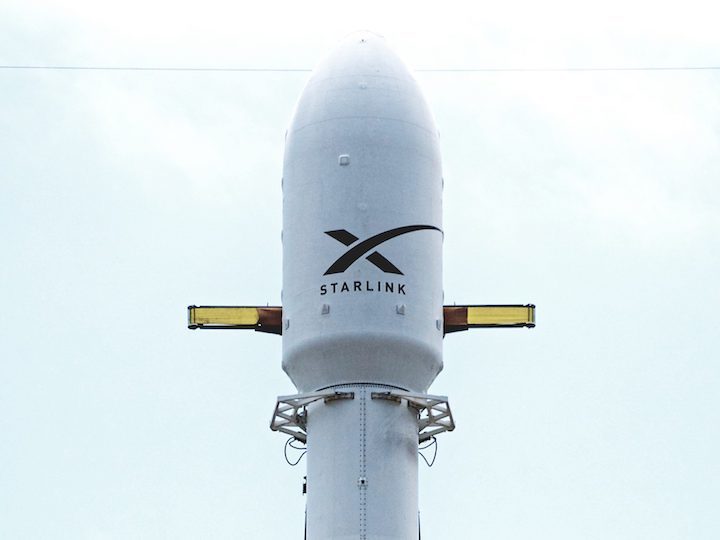
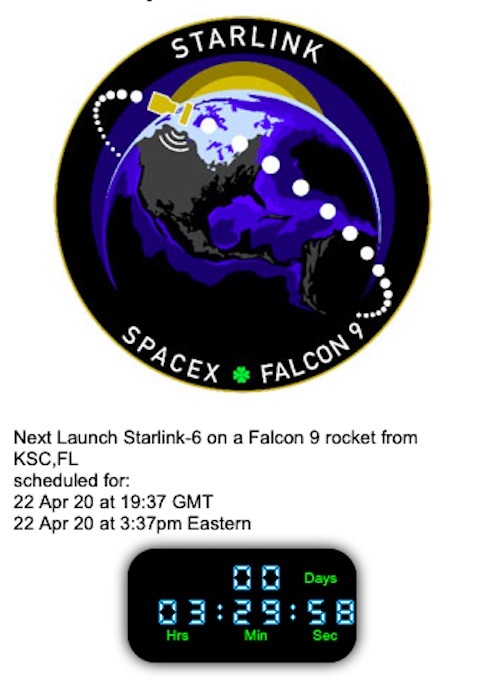
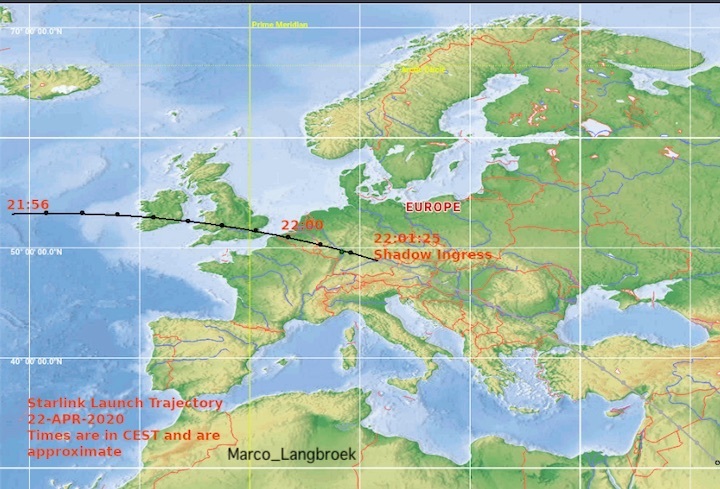
+++
SpaceX moves up Starlink launch from Kennedy Space Center
Update: SpaceX is now targeting 3:30 p.m. Wednesday for liftoff from pad 39A, which is seven minutes earlier than scheduled.
Rarely do rockets launch earlier than planned.
But that's just what will happen at 3:37 p.m. Wednesday when a SpaceX Falcon 9 rocket lofts 60 Starlink internet satellites to orbit from Kennedy Space Center's pad 39A. Teams had been targeting Thursday afternoon for liftoff, but moved up the window due to anticipated weather conditions.
"With a more favorable weather forecast for launch and landing, now targeting Wednesday," SpaceX said via Twitter on Monday.
SpaceX requested and was approved for an hour-long window – 3:07 p.m. to 4:07 p.m. – and is opting to fly in the middle. Whether or not teams can push beyond 3:37 p.m. remains unclear.
The latest Space Force forecast confirmed favorable conditions during the window, noting the spaceport will see weather in the range of 90% "go" thanks to mostly dry conditions and light winds. In the event of a delay to Thursday, however, forecast drops to 50% "go" due to the possibility of afternoon storms.
This mission will mark the seventh under the Starlink banner, which aims to deliver high-speed internet connectivity from low-Earth orbit. Users on the ground would just need a small, pizza box-sized terminal to gain internet access from anywhere in the world.
With this launch, the network's size will push beyond 400 satellites. SpaceX hopes to eventually have thousands of the small spacecraft circling the Earth at all times, providing even high-speed access across the globe. Service, which will begin first in the U.S., could begin rolling out as soon as late this year.
After liftoff, the Falcon 9 rocket's 156-foot-tall first stage will initiate maneuvers to land on the Of Course I Still Love You drone ship in the Atlantic, then return to Port Canaveral a few days later for inspection and refurbishment. Wednesday's launch will mark its fourth mission.
Spectators out to watch the launch should remember to keep in line with the Florida Department of Health's coronavirus social distancing measures, which recommend avoiding crowds and maintaining at least six feet between people.
Launch Wednesday
- Rocket: SpaceX Falcon 9
- Mission: 60 Starlink internet satellites
- Launch Time: 3:37 p.m.
- Launch Pad: 39A at Kennedy Space Center
- Landing: Of Course I Still Love You drone ship
- Weather: 90% "go"
Quelle: Florida Today
+++
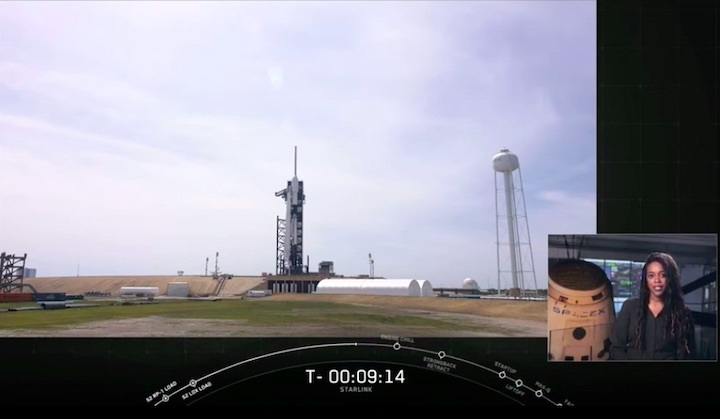
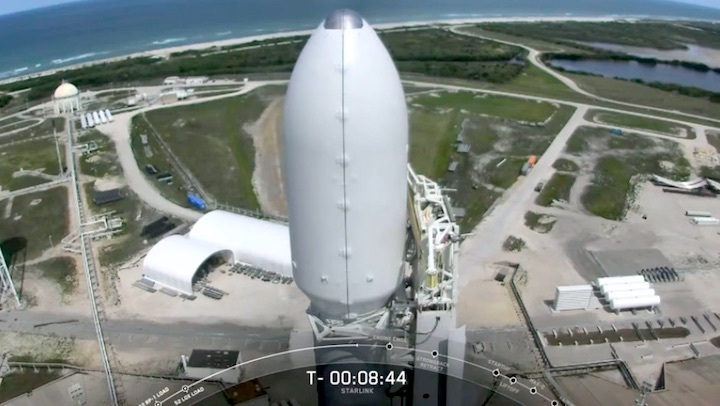
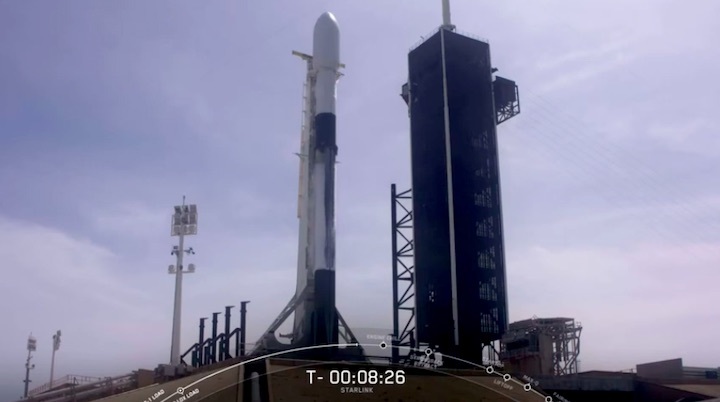
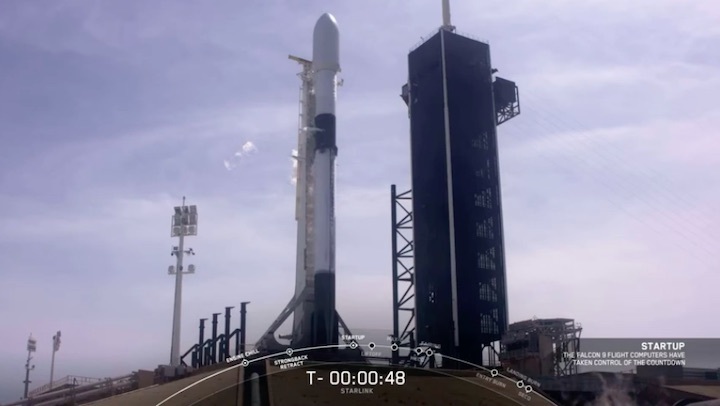
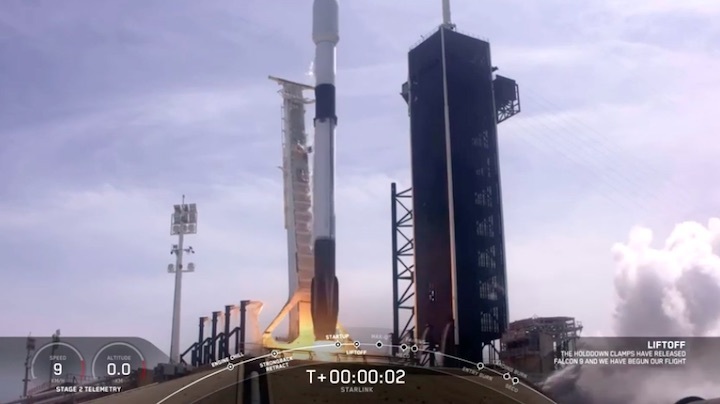
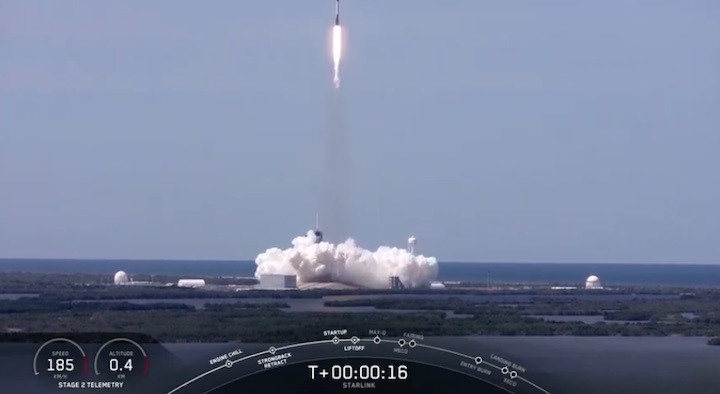
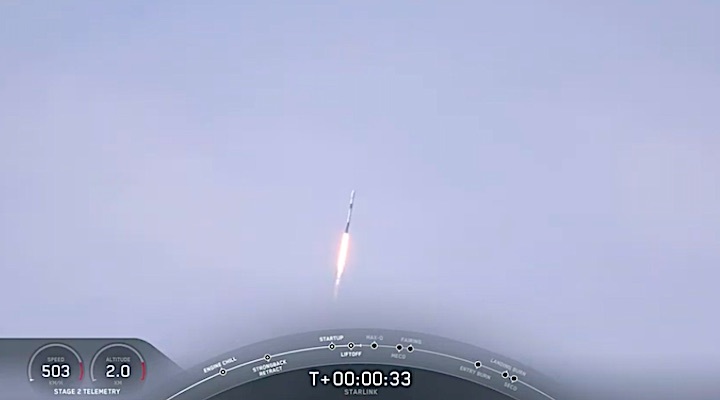
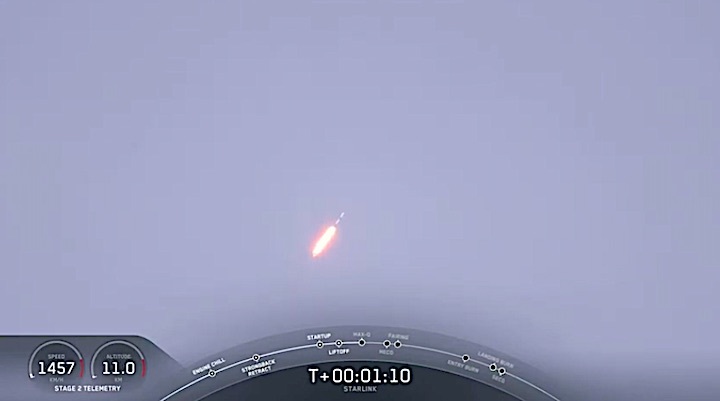
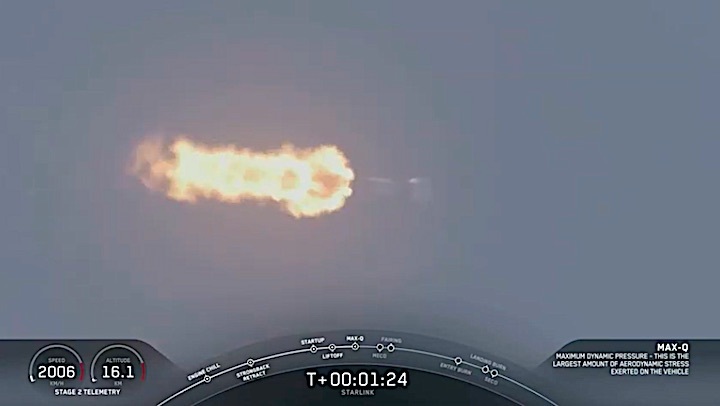
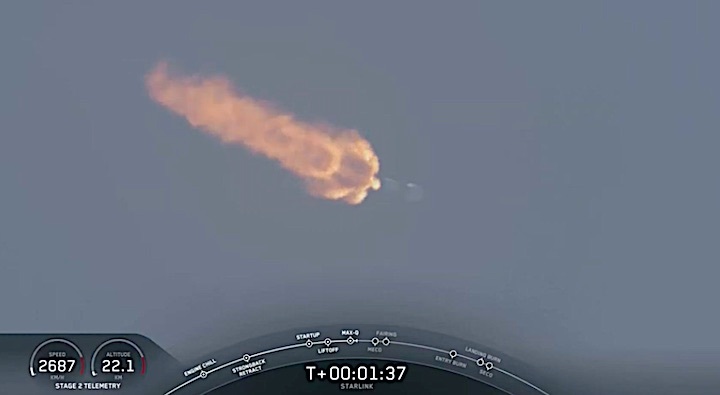
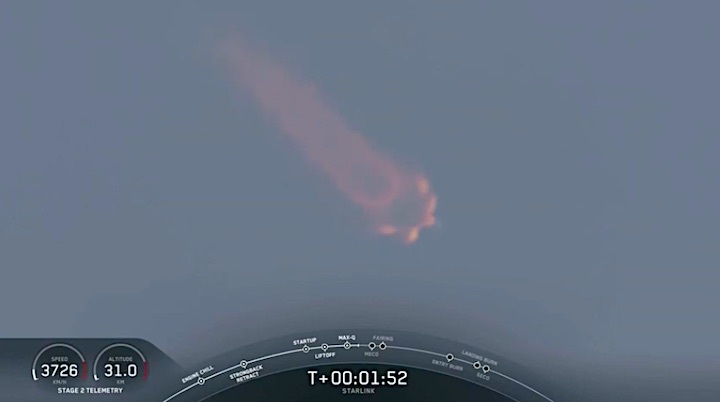
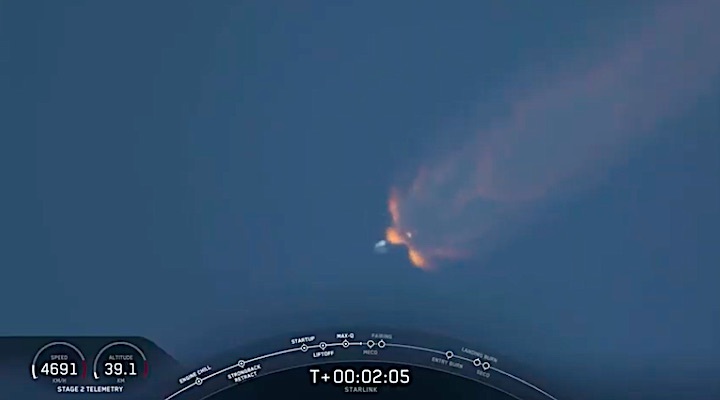
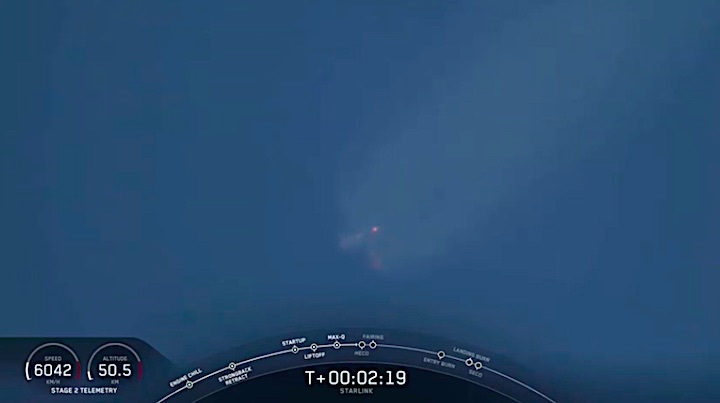
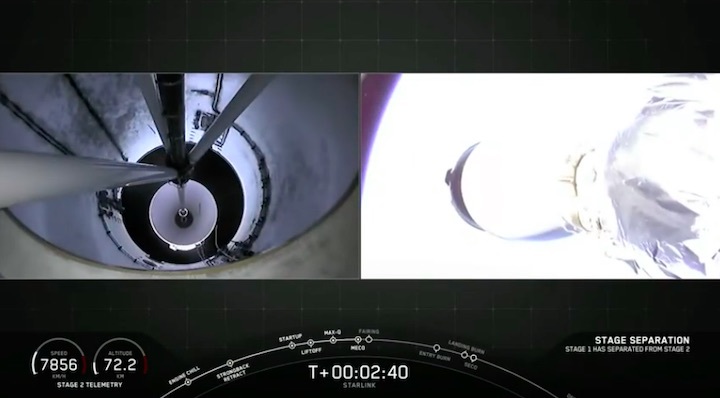
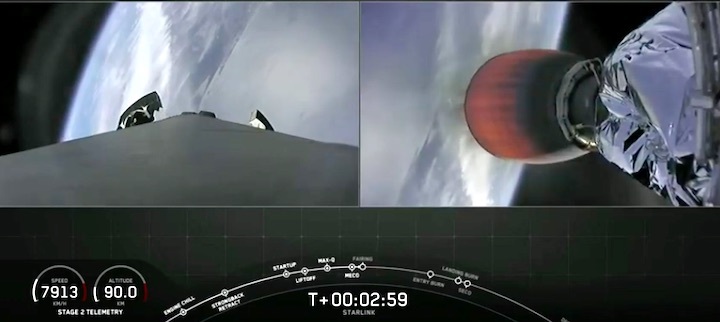
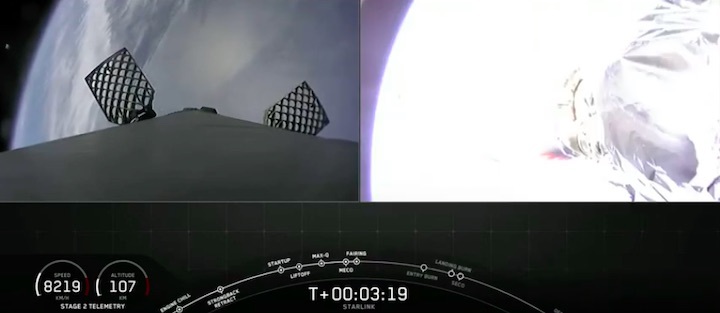
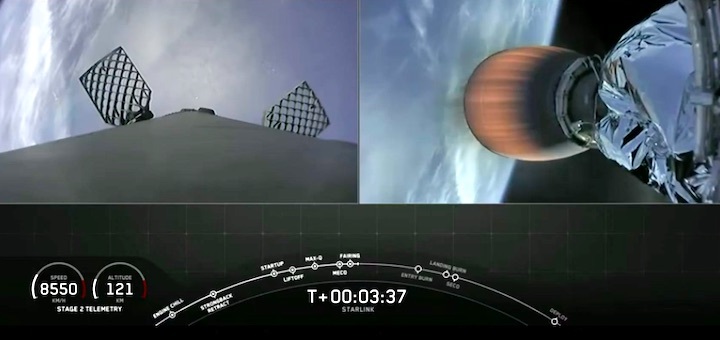
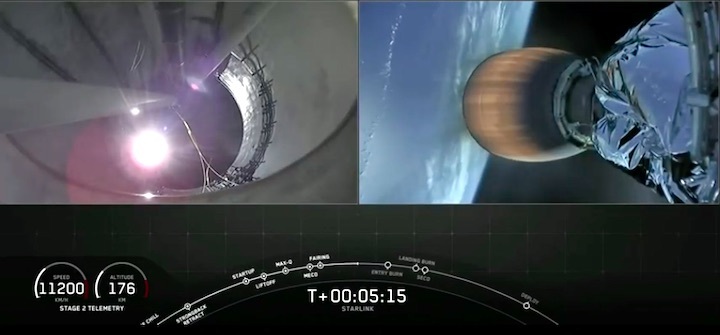
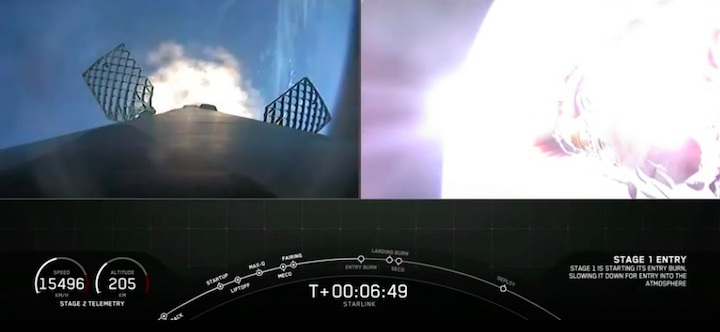
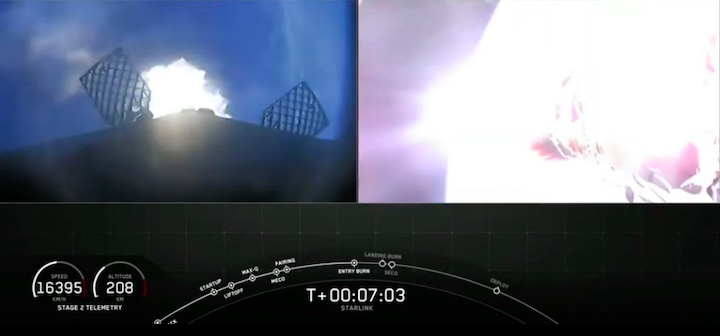
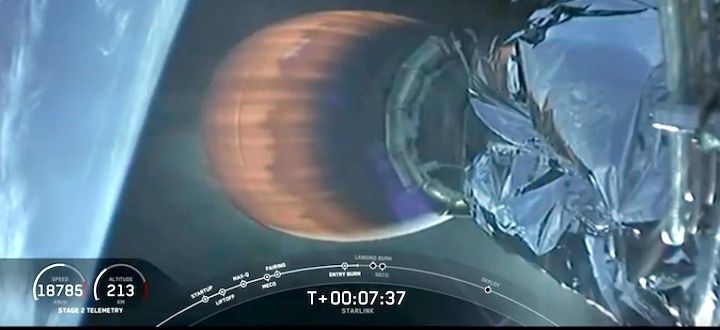
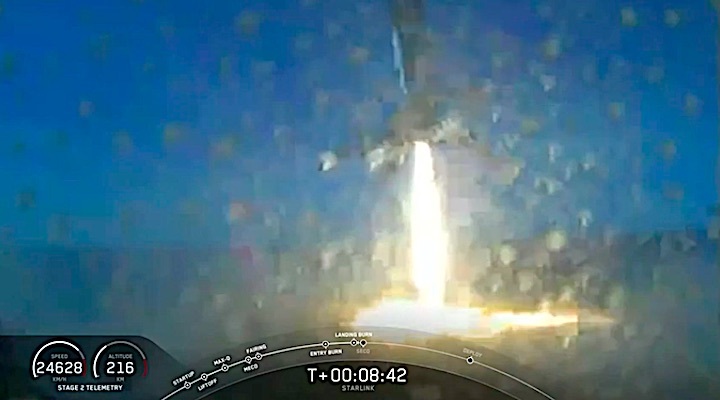
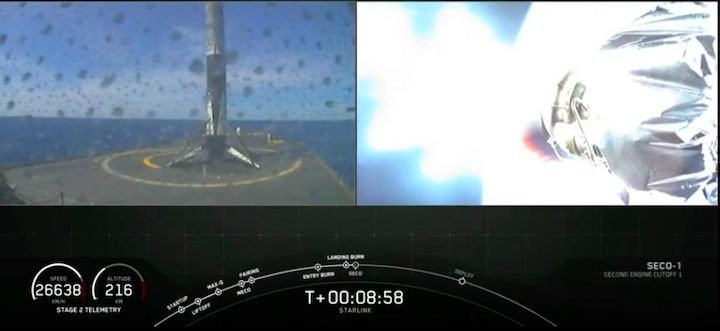
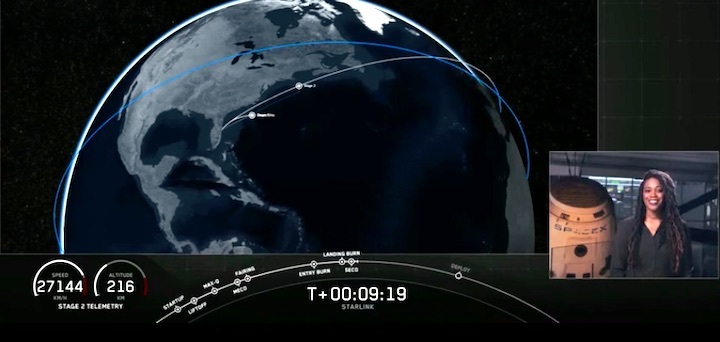
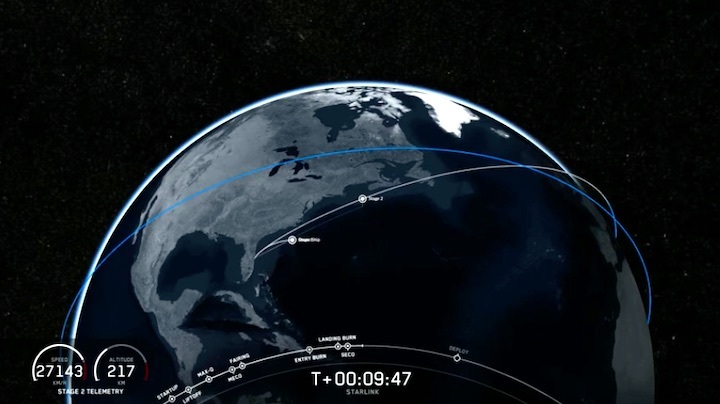
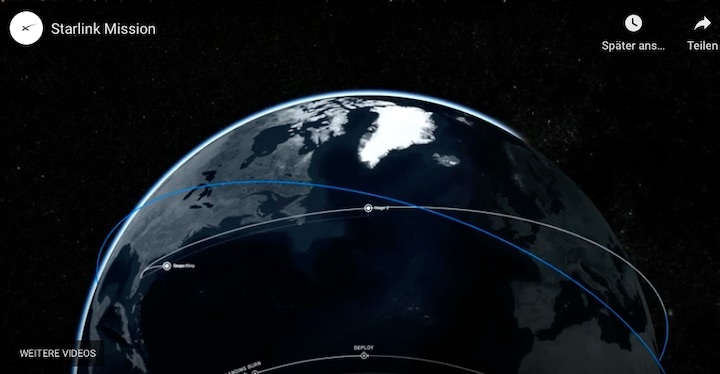
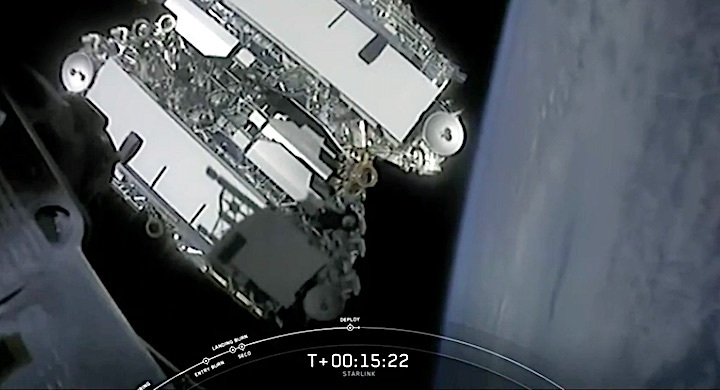
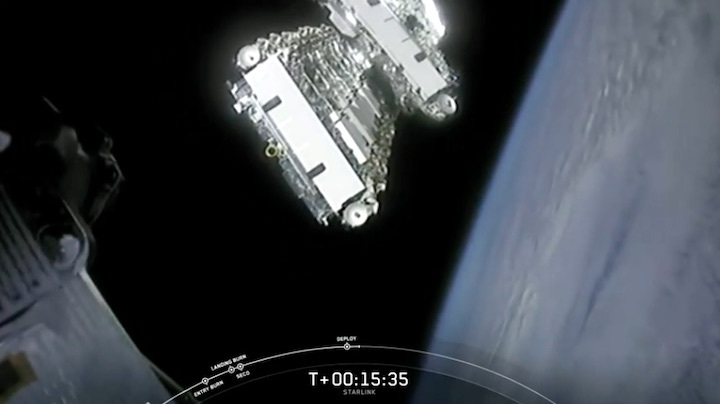
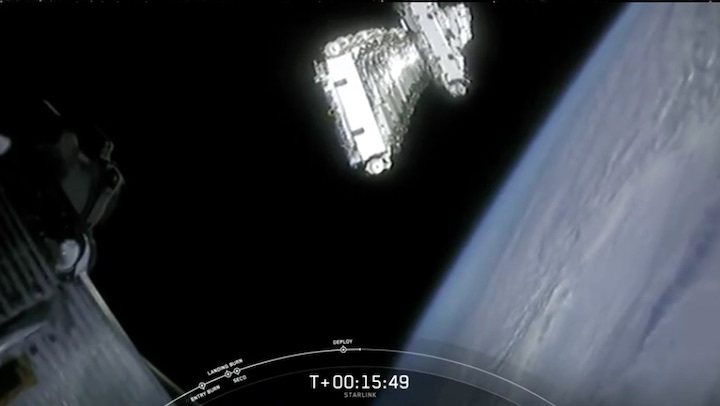
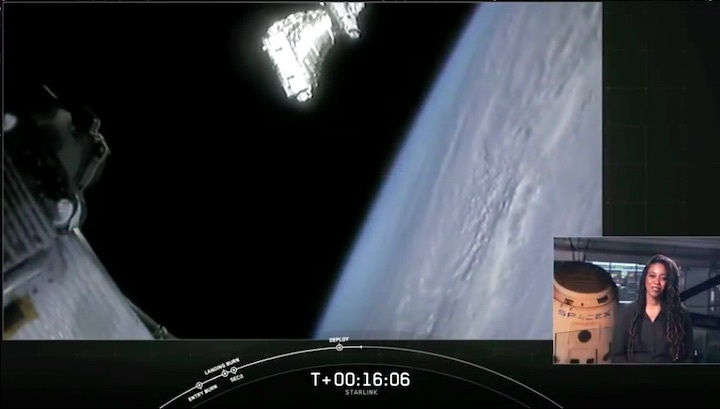
Quelle: SpaceX
